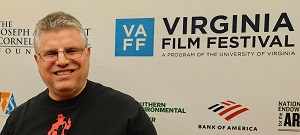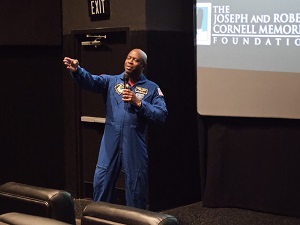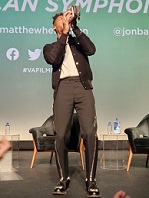|
|
|
|
|
|
Three Days in Charlottesville

From ages eight to eleven I lived with my mother and brother in Charlottesville, Virginia. We moved away in 1984, but Iíve returned there periodically and am still attached to the home of Thomas Jefferson and the University of Virgina. In many ways Charlottesville remains a college town in the best sense of the term, even after the infamous white supremacist uprising in 2017. It combines Southern charm with a cosmopolitan sophistication. You can see the Blue Ridge Mountains while still having the amenities of a larger city. For the past 36 years, Charlottesville has hosted the annual Virginia Film Festival. Friends have urged me to go for many years. I honestly donít know why it took me this long. One reason might be that as a die-hard Yankee fan, I didnít want to be away during the baseball postseason. This year the Yankees solved that problem through their mediocre play, missing the playoffs entirely. My wife Sarit urged me to go, and I took her advice. On the last Friday in October, I made the trip to Charlottesville and settled in at the Violet Crown, a theater Iím sure did not exist when I lived there. As the lights went down I thought back to the years I spent going to the Toronto International Film Festival. While this festival was on a much smaller scale, I got a similar feeling of anticipation. That didnít last long. Regrettably I chose to watch several short films by Kevin Jerome Emerson. According to the festival staff Emerson is an accomplished director of both documentary and short films. Iíll need to take their word for it, because nothing on screen showed any talent. Sidney Lumet said that style should serve the story, but Emersonís style too often crushes any story. One short featured a Detroit zoologist, who when she started was one of the few African-Americans in that profession. She describes her beginnings and what working with animals means to her. Thanks to Emerson you never really see her, as the camera shakes and Emerson stays in an extreme closeup on her room and different parts of her body. The camera often loses focus, with blurry shots that made me wonder if the cinematographer was sober or paying any attention at all. Another short showed a juvenile prison shut down more than 30 years ago due to inhumane conditions. But I only found that out at the Q&A. The film just showed images with no context. Thankfully the festivalís offerings got better from there. I watched a couple of films set in Charlottesville. In one of them, For the Taking, I actually saw the hotel where I was staying, a first for me. Many people who worked on the film were in the audience, along with their friends, for the world premiere. That energy and enthusiasm filled the theater, and I only hoped For the Taking would prove worthy, and it did. Writer-Director Danny Wagner delivers a 16mm poor manís Coen brothers film, getting laughs through woefully inept criminals. Wagner grounds the film in the recent pandemic and the desperation resulting from layoffs. While the story is not as clever as it tries to be, its earnestness and love for its characters make up for it. Finlandís Fallen Leaves, winner of the Jury Prize at Cannes this year, proved funny in a very different way. A woman in my row said afterwards that ďthere was not one ounce of sugar in it,Ē and she was right. Calling it deadpan would be an understatement, as I donít believe anyone smiled until the filmís last ten minutes. The plot on the surface seems to be Romantic Comedy 101. Two mismatched people overcome a variety of obstacles to find true love. Writer-director Aki Kaurismški tells the story in such a dry, understated way that it never feels like a clichť. The two leads, Alma PŲysti and Jussi Vatanen, accomplish so much through small looks and gestures. Kaurismški includes a clip from Jim Jarmuschís The Dead Donít Die, and like Jarmusch, he finds the beat of the film through its silences. At the other end of the emotional scale was the dark and compelling thriller Eileen. The title character (Thomasin McKenzie) is a meek, repressed young woman emotionally abused by her alcoholic father (Shea Whigham) and belittled by her colleagues at the juvenile prison where she works. When a glamorous, confident psychologist (Anne Hathaway) joins the staff, Eileen is transfixed by the woman who is everything she wished she could be. Director William Oldroyd slowly builds the dread, making us wait for something bad to happen. Without spoiling, Iíll just say that the bad thing is a true shock, not at all what I expected. You need to suspend your disbelief at times, but its worth it. Hathaway and Whigham have never been better, and McKenzie challenges whatever preconceptions you might have based on her earlier work. As satisfying as Eileen, Fallen Leaves and For the Taking were, for me it was the documentaries that truly shined. Each opened my eyes to aspects of American history and society often overlooked. In an alternate history Ed Dwight would have become Americaís first black astronaut in the mid-60s. President Kennedy personally chose him for this role, but Dwight faced open racism from his colleagues and supervisors. Upon JFKís assassination, Dwight had no allies and was forced out of NASA. The Space Race tells Dwightís story along with the African American pioneering astronauts in the 70s and 80s, including Ron McNair, who died in the Challenger tragedy and Charles Bolden, who later became the first African American NASA Administrator. Directors Lisa Cortes (who recently made a fascinating documentary about Little Richard) and Diego Hurtado de Mendoza keep the right balance between informative and emotional. They wisely keep going back to Dwight, who became a successful sculptor and does not seem bitter even though he would have every reason to be. Leland Melvin, one of the more recent astronauts featured in the film, took questions from the audience in his NASA uniform.  Astronaut Leland Melvin Stamped From the Beginning also tackles racism but doesnít have the happy ending of The Space Race. Through innovative animation, along with the more traditional talking heads and archival footage, Roger Ross Williams explores how and why racist ideas came to be and how they have evolved over time. He spotlights key figures such as Ida B. Wells, an African American journalist who exposed how prevalent lynching was in turn of the century U.S. Williams also challenges popular perceptions of key figures in American history, even Abraham Lincoln. The film educates, provokes, and makes one face uncomfortable truths. Like Williams, Ricardo Preve takes on tough issues, in this case immigration. But Preve does it through a collection of smaller, intimate stories in Sometime, Somewhere. Preve lets migrants just face the camera and talk about how and why they came to the US. They discuss their dreams and their realities. Throughout these testimonies, Preve plays clips from The Grapes of Wrath, connecting the Great Depression hardships and search for a better life with the current migrant struggles. He illustrates how these migrantsí stories are part of the larger American story. So many people demonize migrants as some sort of plague. I wonder if any of them could see Sometime, Somewhere and still feel that way. Up until the festival Iíd never heard of Shere Hite. She was a model known for her indelible sense of style, but that was just the surface. In 1976, she wrote The Hite Report, a groundbreaking look at female sexuality that challenged many stereotypes. Hite based her findings on thousands of anonymous surveys through which women had the freedom to recount their sexual experiences and beliefs. The Disappearance of Shere Hite explores who Hite was, the impact of her research, and the fierce backlash it provoked. Director Nicole Newham and her team found scores of Hiteís letters, which along with her many interviews, put you inside her mind. You canít help but feel for Hite as the film illustrates the unwarranted anger that ended up driving her out of America. Most critically, The Disappearance of Shere Hite shows why Hite mattered and asks why sheís been overlooked. Taken together these four documentaries examine who gets to write history. Who gets to decide whatís included and whatís left out? Some states are changing their educational curriculum to avoid teaching any part of history that might make students or their parents feel uneasy. That type of history doesnít challenge anyone. It just reinforces what people already believe. When I was ten, I saw The Right Stuff and took tremendous pride in what the original Mercury astronauts achieved. But it doesnít diminish their achievements to understand that Ed Dwight did not get the same opportunity because he had the wrong skin color. If believing in Americaís greatness means whitewashing its flaws, then itís a pretty flimsy belief. If oneís masculinity is threatened so much by a report on sexuality maybe thatís a cause for self-reflection rather than pretending the report doesnít exist. The best documentaries open minds through new information or through asking tough questions. In an age when open minds can be hard to come by, thatís no small feat. After some of these weightier films, I looked forward to the closing night with American Symphony, about the musician/bandleader Jon Batiste. American Symphony does feature terrific music; it would be hard not to with Batiste, but the film is no easy ride. Director Matthew Heinemanís earlier work covered drug cartels, war zones, and the early days of COVID, so he wasnít about to do a promotional puff piece. His film covers a year in Batisteís life that includes Grammy wins but also Batisteís wife Suleika Jaouad battling leukemia. Batiste spends the year writing, perfecting, and rehearsing his symphony for a Carnegie Hall concert. Heineman takes us inside Batisteís creative process, which proves fascinating. He also gets Batiste and Jaouad to let their guard down, especially during her medical struggles. When Batiste finally plays at Carnegie Hall, the performance is that much sweeter knowing what he went through on his journey. Both Heineman and Batiste came out afterwards for the Q&A, and Batiste even performed a few songs for the audience. Smiles abounded as the audience left the theater. 

During one of the breaks between films, I realized that prior to the festival, I hadnít seen a film in Charlottesville since 1984. The festival didnít exist when I lived there. Still, the festival showcased some of what I loved about Charlottesville. The staff and volunteers kept the proceedings running seamlessly. I ate well near the theaters and the weather was perfect. And yes, I could still see the Blue Ridge Mountains. While I donít know exactly when Iíll return for the festival, I promise it will be much sooner than 39 years. Adam Spector November 1, 2023 Contact us: |
|
